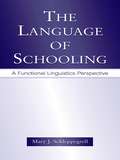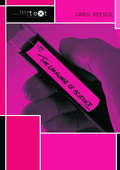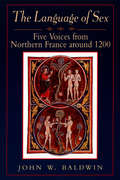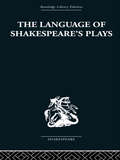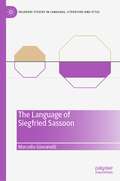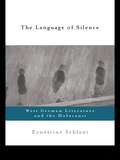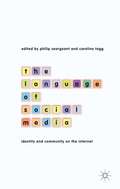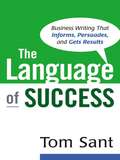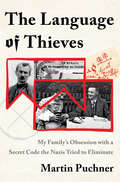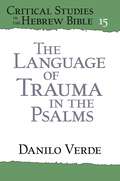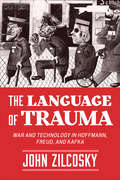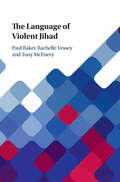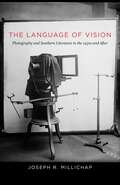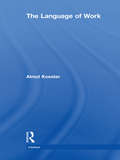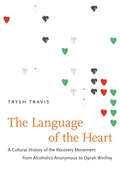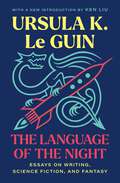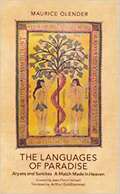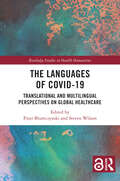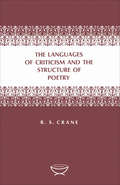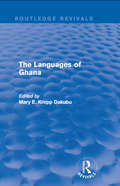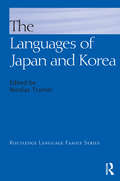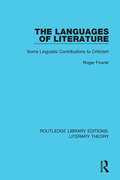- Table View
- List View
The Language of Schooling: A Functional Linguistics Perspective
by Mary J. SchleppegrellThis book is about how language is used in the context of schooling. It demonstrates that the variety of English expected at school differs from the interactional language that students use for social purposes outside of school, and provides a linguistic analysis of the challenges of the school curriculum, particularly for non-native speakers of English, speakers of non-standard dialects, and students who have little exposure to academic language outside of schools. The Language of Schooling: A Functional Linguistics Perspective builds on current sociolinguistic and discourse-analytic studies of language in school, but adds a new dimension--the framework of functional linguistic analysis. This framework focuses not just on the structure of words and sentences, but on how texts are constructed--how particular grammatical choices create meanings in the different kinds of texts students are asked to read and write at school. The Language of Schooling: A Functional Linguistics Perspective*provides a functional description of the kinds of texts students are expected to read and write at school;*relates research from other sociolinguistic and language development perspectives to research from the systemic functional linguistics perspective;*focuses on the increasing linguistic demands of contexts of advanced literacy (middle school through college);*analyzes the genres typically encountered at school, with extensive description of the grammatical features of the expository essay, a gatekeeping genre for secondary school graduates;*reviews the grammatical features of disciplinary genres in science and history; and*argues for more explicit attention to language in teaching all subjects, with a particular focus on what is needed for the development of critical literacy.This book will enable researchers and students of language in education to recognize how the grammatical and discourse features of the language of schooling construct the content areas, role relationships, and purposes and expectations of schools. It also will enable them to better understand the nature of language itself and how it emerges from and helps to maintain social structures and institutions, and to apply these understandings to creating classroom environments that build on the strengths students bring to school.
The Language of Science (Intertext)
by Carol ReevesThe communication of scientific principles is becoming increasingly important in a world that relies on technology. Exploring the use of scientific language in the news and examining how important scientific ideas are reported and communicated, this title in the Intertext series takes a look at the use and misuse of scientific language and how it shapes our lives. The Language of Science: explores the goals of, and problems with, scientific language and terminology demonstrates the power and misuse of scientific discourse in the media examines the special qualities of scientific communication explores how science and popular culture interact is illustrated with a wide range of examples from the MMR vaccine to AIDS and the biological weapons debate, and includes a glossary as well as ideas for further reading. This practical book is ideal for post-16 to undergraduate students in English Language, Linguistics, Journalism, Communications Studies or Science Communication.
The Language of Service Encounters: A Pragmatic-Discursive Approach
by J. César Félix-BrasdeferService encounters are ubiquitous in social interaction. We buy food and everyday items in supermarkets, convenience stores, or markets; we purchase merchandise in department stores; or we request information at a visitor information center. This book offers a comprehensive account of service encounters in commercial and non-commercial settings. Grounded in naturally occurring face-to-face interactions and drawing on a pragmatic-discursive approach, J. César Félix-Brasdefer sets out a framework for the analysis of transactional and relational talk in various contexts in the United States and Mexico. This book investigates cross-cultural and intra-lingual pragmatic variation during the negotiation of service. The author provides a broad review of research on service encounters to date, and analyzes characteristics of sales transactions, such as participants' roles, pragmatic and discourse functions of relational talk and address forms, the realization of politeness, and changes in alignment from transactional to relational talk. Examines face-to-face interactions in commercial and non-commercial service encounter settings, including the analysis of transactional and non-transactional talk. Analyzes pragmatic and sociolinguistic variation, including linguistic, regional, intra-lingual, and gender variation. Reviews and evaluates methods and techniques for the collection and analysis of corpus data in service encounters in naturalistic settings.
The Language of Sex: Five Voices from Northern France around 1200
by John W. BaldwinThis study brings together widely divergent discourses to fashion a comprehensive picture of sexual language and attitudes at a particular time and place in the medieval world. John Baldwin introduces five representative voices from the turn of the twelfth century in northern France: Pierre the Chanter speaks for the theological doctrine of Augustine; the Prose Salernitan Questions, for the medical theories of Galen; Andre the Chaplain, for the Ovidian literature of the schools; Jean Renart, for the contemporary romances; and Jean Bodel, for the emerging voices of the fabliaux. Baldwin juxtaposes their views on a range of essential subjects, including social position, the sexual body, desire and act, and procreation. The result is a fascinating dialogue of how they agreed or disagreed with, ignored, imitated, or responded to each other at a critical moment in the development of European ideas about sexual desire, fulfillment, morality, and gender. These spokesmen allow us into the discussion of sexuality inside the church and schools of the clergy, in high and popular culture of the leity. This heterogeneous discussion also offers a startling glimpse into the construction of gender specific to this moment, when men and women enjoyed equal status in sexual matters, if nowhere else. Taken together, these voices extend their reach, encompass their subject, and point to a center where social reality lies. By articulating reality at its varied depths, this study takes its place alongside groundbreaking works by James Brundage, John Boswell, and Leah Otis in extending our understanding of sexuality and sexual behavior in the Middle Ages. "Superb work. . . . These five kinds of discourse are not often treated together in scholarly writing, let alone compared and contrasted so well. "—Edward Collins Vacek, Theological Studies "[Baldwin] has made the five voices speak to us in a language that is at one and the same time familiar and alien in its resonance and accents. This is a truly exceptional book, interdisciplinary in the real sense of the word, which is surely destined to become a landmark in medieval studies. "—Keith Busby, Bryn Mawr Reviews "[Baldwin's] attempt to 'listen' to these distant voices and translate their language of sex into our own raises challenging methodological questions that will be of great interest to historians and literary scholars alike. "—John P. Dalton, Comitatus
The Language of Shakespeare's Plays
by B. I. EvansFirst published in 1952. This volume explores the function of verse in drama and the developing way in which Shakespeare controlled the rhetorical and decorative elements of speech for the dramatic purpose. The Language of Shakespeare's Plays explores the plays chronologically and so covers all the outstanding problems of Shakespearian language in a way that makes reference easy, without any loss of a continuing narrative.
The Language of Siegfried Sassoon (Palgrave Studies in Language, Literature and Style)
by Marcello GiovanelliThis book presents a cognitive stylistic analysis of the writing of Siegfried Sassoon, a First World War poet who has typically been perceived as a poet of protest and irony, but whose work is in fact multi-faceted and complex in theme and shifted in style considerably throughout his lifetime. The author starts from the premise that a more systematic account of Sassoon’s style is possible using the methodology of contemporary stylistics, in particular Cognitive Grammar. Using this as a starting point, he revisits common ideas from Sassoon scholarship and reconfigures them through the lens of cognitive stylistics to provide a fresh perspective on Sassoon's style. This book will be of interest to students and scholars of stylistics, war poetry, twentieth-century literature, and cognitive linguistics.
The Language of Silence: West German Literature and the Holocaust
by Ernestine SchlantFocusing on individual authors from Heinrich Boll to Gunther Grass, Hermann Lenz to Peter Schneider, The Language of Silence offers an analysis of West German literature as it tries to come to terms with the Holocaust and its impact on postwar West German society. Exploring postwar literature as the barometer of Germany's unconsciously held values as well as of its professed conscience, Ernestine Schlant demonstrates that the confrontation with the Holocaust has shifted over the decades from repression, circumvention, and omission to an open acknowledgement of the crimes. Yet even today a 'language of silence' remains since the victims and their suffering are still overlooked and ignored. Learned and exacting, Schlant's study makes an important contribution to our understanding of postwar German culture.
The Language of Social Media
by Philip Seargeant Caroline TaggThis timely book examines language on social media sites including Facebook and Twitter. Studies from leading language researchers, and experts on social media, explore how social media is having an impact on how we relate to each other, the communities we live in, and the way we present a sense of self in twenty-first century society.
The Language of Success: Business Writing That Informs, Persuades, And Gets Results
by Tom SantLanguage is the medium of business. To be successful, we need to communicate effectively in writing. That’s true whether we are providing instructions to our colleagues, communicating with our customers, or advising our direct reports. We must be able to deliver clear, accurate messages that inform, persuade and motivate. Unfortunately, people lapse into habits that interfere with their ability to communicate. The Language of Success shows readers ho to avoid these mistakes, and to write lucid, concise, and accurate e-mails, letters, performance appraisals, and presentations. Now anyone can master the lost art of clear writing and: * eliminate ambiguities, jargon and grandiose claims * master proper paragraph structure so the message doesn’t get muddled * avoid wishy-washy or misleading terms like "world class" or "state of the art" * write clear concise sentences that follow the "first time right rule" * use e-mail professionally and efficiently * create career-enhancing reports Honest and authoritative, The Language of Success will gives readers practical techniques to help readers cut through the fluff, guff, geek, and hyperbole, write exceptional business documents, and get their message heard.
The Language of Suspense in Crime Fiction
by Reshmi Dutta-FlandersThis book introduces readers to linguistic stylistic analysis and combines both literary and linguistic analysis to explore suspense in crime fiction. Employing critical linguistics, discourse analysis and functional grammar, it demonstrates that suspense in plot-based stories is created through non-linear, causative presentation of the narrative. The author investigates how plot sequence is manipulated to ensure the reader cannot resolve the order of events until the end of the tale. From two-dimensional circumstantial detection in mystery stories to three-dimensional re-evaluation of offender orientation, she uses a linguistic-based stylistic framework to analyse offender motive. She also employs a 'discourse-based' frame analysis to examine the plot structure of crime stories for micro context and set-up scenarios, demonstrating that it is the unravelling of these devices that creates the suspense in murder mysteries and thrillers alike. Finally, she shows how grammaticization of the offending-self reveals an embedded diegetic space in the offender engagement discourse, provoking an intellectual and affective response and reshaping our overall outlook of the crime in the story. This book will appeal to researchers and students from literary and non-literary backgrounds looking for theoretical and practical advice on the linguistic stylistic approach to reading texts.
The Language of Thieves: My Family's Obsession With A Secret Code The Nazis Tried To Eliminate
by Martin PuchnerTracking an underground language and the outcasts who depended on it for their survival. Centuries ago in middle Europe, a coded language appeared, scrawled in graffiti and spoken only by people who were "wiz" (in the know). This hybrid language, dubbed Rotwelsch, facilitated survival for people in flight—whether escaping persecution or just down on their luck. It was a language of the road associated with vagabonds, travelers, Jews, and thieves that blended words from Yiddish, Hebrew, German, Romani, Czech, and other European languages and was rich in expressions for police, jail, or experiencing trouble, such as "being in a pickle." This renegade language unsettled those in power, who responded by trying to stamp it out, none more vehemently than the Nazis. As a boy, Martin Puchner learned this secret language from his father and uncle. Only as an adult did he discover, through a poisonous 1930s tract on Jewish names buried in the archives of Harvard’s Widener Library, that his own grandfather had been a committed Nazi who despised this "language of thieves." Interweaving family memoir with an adventurous foray into the mysteries of language, Puchner crafts an entirely original narrative. In a language born of migration and survival, he discovers a witty and resourceful spirit of tolerance that remains essential in our volatile present.
The Language of Trauma in the Psalms (Critical Studies in the Hebrew Bible)
by Danilo VerdeOver the last few decades, the field of trauma studies has shed new light on biblical texts that deal with individual and collective catastrophe. In The Language of Trauma in the Psalms, Danilo Verde advances the conversation, moving beyond the emphasis on healing that prevails in most literary trauma studies. Using the lens of cognitive linguistics and combining insights from trauma studies and redaction criticism, Verde explores how trauma is expressed linguistically in the book of Psalms, how trauma-related language was rooted in ancient Israel’s external realities, and how psalms helped define Yehud’s cultural trauma in the Persian period (539–331 BCE). Rather than assuming the psalmists’ personal experiences are reflected in these texts, Verde focuses on the linguistic strategies used to express trauma in the Psalms, especially references to the body and highly dramatic metaphors. Current analyses often approach trauma texts as tools intended to help sufferers heal. Verde contends that many group laments in the book of Psalms were transmitted not only to heal but also to wound the community, ensuring that the pain of a previous generation was not forgotten.The Language of Trauma in the Psalms shifts our understanding of trauma in biblical texts and will appeal to literary trauma scholars as well as those interested in ancient Israel.
The Language of Trauma: War and Technology in Hoffmann, Freud, and Kafka
by John ZilcoskyFrom the Napoleonic Wars to the invention of the railway to the shell shock of World War I, writers tried to give voice to the suffering that war and industrial technology had wrought all around them. Yet they, like the doctors who treated these victims, repeatedly ran up against the incapacity of language to describe such anguish; those who suffered trauma, those who tried to heal it, and those who represented it were all unable to find the appropriate words. In The Language of Trauma, John Zilcosky uncovers the reactions of three major central European writers – E.T.A. Hoffmann, Sigmund Freud, and Franz Kafka – to the birth of modern trauma in the nineteenth and early twentieth centuries. Zilcosky makes the case that Hoffmann, Freud, and Kafka managed to find the language of trauma precisely by not attempting to name the trauma conclusively and instead allowing their writing to mimic the experience itself. Just as the victims’ symptoms seemed not to correspond to a physical cause, the writers’ words did not connect directly to the objects of the world. While doctors attempted to overcome this indeterminacy, these writers embraced and investigated it; they sought a language that described language’s tragic limits and that, in so doing, exemplified the wider literary and philosophical crisis of their time. Zilcosky boldly argues that this linguistic scepticism emerged together with the medical inability to name the experience of trauma. He thereby places trauma where it belongs: at the heart of both medicine’s diagnostic predicament and modern literature’s most daring experiments.
The Language of Violent Jihad
by Paul Baker Rachelle Vessey Tony McEneryHow do violent jihadists use language to try to persuade people to carry out violent acts? This book analyses over two million words of texts produced by violent jihadists to identify and examine the linguistic strategies employed. Taking a mixed methods approach, the authors combine quantitative methods from corpus linguistics, which allow the identification of frequent words and phrases, alongside close reading of texts via discourse analyses. The analysis compares language use across three sets of texts: those which advocate violence, those which take a hostile but non-violent standpoint, and those which take a moderate perspective, identifying the different uses of language associated with different stages of radicalization. The book also discusses how strategies including use of Arabic, romanisation, formal English, quotation, metaphor, dehumanisation and collectivisation are used to create in and out groups and justify violence.
The Language of Vision: Photography and Southern Literature in the 1930s and After (Southern Literary Studies)
by Joseph R. MillichapThe Language of Vision celebrates and interprets the complementary expressions of photography and literature in the South. Southern imagery and text affect one another, explains Joseph R. Millichap, as intertextual languages and influential visions. Focusing on the 1930s, and including significant works both before and after this preeminent decade, Millichap uncovers fascinating convergences between mediums, particularly in the interplay of documentary realism and subjective modernism.Millichap's subjects range from William Faulkner's fiction, perhaps the best representation of literary and graphic tensions of the period, and the work of other major figures like Robert Penn Warren and Eudora Welty to specific novels, including Ralph Ellison's Invisible Man and James Agee's Let Us Now Praise Famous Men. Fleshing out historical and cultural background as well as critical and theoretical context, Millichap shows how these texts echo and inform the visual medium to reveal personal insights and cultural meanings. Warren's fictions and poems, Millichap argues, redefine literary and graphic tensions throughout the late twentieth century; Welty's narratives and photographs reinterpret gender, race, and class; and Ellison's analysis of race in segregated America draws from contemporary photography. Millichap also traces these themes and visions in Natasha Trethewey's contemporary poetry and prose, revealing how the resonances of these artistic and historical developments extend into the new century. This groundbreaking study reads southern literature across time through the prism of photography, offering a brilliant formulation of the dialectic art forms.
The Language of Work (Intertext)
by Almut KoesterThe Intertext series has been specifically designed to meet the needs of contemporary English Language Studies. Working with Texts: A Core Introduction to Language Analysis (second edition 2001) is the foundation text, which is complemented by a range of 'satellite' titles. These provide students with hands-on practical experience of textual analysis through special topics, and can be used individually or in conjunction with Working with Texts. The Language of Work: examines how language is used in business and the workplace, looking at a range of situations and data: from meetings to informal negotiations, promotional letters to emails explores representations of work in advertising, career magazines and workplace talk looks at the way people in business interact through small talk, politeness, customer care and management-employee relationships is illustrated with lively examples taken from the real world and includes a full index of terms features a useful section on entering the world of work, exploring job adverts and texts that give advice on CV writing and developing 'transferable skills'.
The Language of the Heart: A Cultural History of the Recovery Movement from Alcoholics Anonymous to Oprah Winfrey
by Trysh TravisInThe Language of the HeartTrysh Travis explores the rich cultural history of Alcoholics Anonymous (AA) and its offshoots and the larger "recovery movement" that has grown out of them. Moving from AA's beginnings in the mid-1930s as a men's fellowship that met in church basements to the thoroughly commercialized addiction treatment centers of today, Travis chronicles the development of recovery and examines its relationship to the broad American tradition of self-help, highlighting the roles that gender, mysticism, and print culture have played in that development. Travis draws on hitherto unexamined materials from AA's archives as well as a variety of popular recovery literatures. Her analysis traces AA's embrace of the concept of alcoholism as disease, the rise of feminist sobriety discourse and the codependence theories of the 1970s and 80s, and Oprah Winfrey's turn-of-the-millennium popularization of metaphysical healing. What unites these varied cultures of recovery, Travis argues, is their desire to offer spiritual solutions to problems of gender and power. Treating self-help seekers as individuals whose intellectual and aesthetic traditions are worth excavating,The Language of the Heartis the first book to attend to the evolution and variation found within the recovery movement and to treat recovery with the attention to detail that its complexity requires.
The Language of the Night: Essays on Fantasy and Science Fiction
by Ursula K. Le Guin"In these conversational, feisty essays, an energizing mind trip for SF fans, she dissects her own fiction, discusses technique and explores the potential of SF and fantasy, which she considers different branches of the same form of writing."--from "Publisher's Weekly"
The Language of the Night: Essays on Writing, Science Fiction, and Fantasy
by Ursula K. Le GuinFeaturing a new introduction by Ken Liu, this revised edition of Ursula K. Le Guin&’s first full-length collection of essays covers her background as a writer and educator, on fantasy and science fiction, on writing, and on the future of literary science fiction.&“We like to think we live in daylight, but half the world is always dark; and fantasy, like poetry, speaks the language of the night.&” —Ursula K. Le Guin Le Guin&’s sharp and witty voice is on full display in this collection of twenty-four essays, revised by the author a decade after its initial publication in 1979. The collection covers a wide range of topics and Le Guin&’s origins as a writer, her advocacy for science fiction and fantasy as mediums for true literary exploration, the writing of her own major works such as A Wizard of Earthsea and The Left Hand of Darkness, and her role as a public intellectual and educator. The book and each thematic section are brilliantly introduced and contextualized by Susan Wood, a professor at the University of British Columbia and a literary editor and feminist activist during the 1960s and &’70s. A fascinating, intimate look into the exceptional mind of Le Guin whose insights remain as relevant and resonant today as when they were first published.
The Languages Of Paradise: Aryans And Semites A Match Made In Heaven
by Arthur Goldhammer Maurice OlenderMichel Foucault observed that "the birth of philology attracted far less notice in the Western mind than did the birth of biology or political economy." In this penetrating exploration of the origin of the discipline, Maurice Olender shows that philology left an indelible mark on Western visions of history, and contributed directly to some of the most horrifying ideologies of the twentieth century.
The Languages of COVID-19: Translational and Multilingual Perspectives on Global Healthcare (Routledge Studies in Health Humanities)
by Piotr Blumczynski and Steven WilsonThis collection advocates for languages-based, translational research to be part of the partnerships and collaborations required to make sense of, and respond to, COVID-19 as one of the major global challenges of our time. Bringing together scholars and practitioners from a wide range of disciplines, this volume is bound by a common thread stressing the importance of linguistic sensitivity, (inter)cultural knowledge and translational mediation on the frontline response to COVID-19. Featuring contributors from around the world and reflecting on the language used to frame COVID-19 in diverse cultural contexts of the Global North and Global South, the book argues that paying attention to the transmission of ideas, ideologies, narratives, and history through processes of translation results in a broadening of social, cultural and medical understandings of COVID-19. Spanning nearly twenty signed and spoken languages, the volume argues that only in going beyond an Anglophone perspective can we better understand the cultural, social and political facets of the pandemic and, in turn, produce a comprehensive efficient global response to disease management. This book will be of interest to scholars in translation and interpreting studies, modern languages, applied linguistics, cultural studies, Deaf studies, intercultural communication, and medical humanities.
The Languages of Criticism and the Structure of Poetry
by Ronald CraneThese vigorous lectures deal with some of the many ways in which the question of structure in poetry (here synonymous with the whole range of artistic creation in words) can be discussed. Criticism has never been, Professor Clare argues, a single discipline, but a collection of more and less distinct conceptual "languages," within any one of which a literary problem takes on a special solution. The Alexander Lectures for 1952.
The Languages of Ghana (Routledge Revivals)
by Mary E. Kropp DakubuFirst published in 1988, this book provides an easily accessible handbook of knowledge about the languages of Ghana; their geographical distribution, their relationships with each other, the social patterns of their use, and their structures. Besides the general introduction, it contains chapters on each of the individually recognised families of languages spoken in Ghana: Gur, Volta-Comoé, Gbe, Ga-Dangme, Central-Tongo and Mande. An additional chapter outlines the use of non-indigenous languages in the country.
The Languages of Japan and Korea (Routledge Language Family Ser.)
by Nicolas TranterThe Languages of Japan and Korea provides detailed descriptions of the major varieties of languages in the region, both modern and pre-modern, within a common format, producing a long-needed introductory reference source. Korean, Japanese, Ainu, and representative members of the three main groupings of the Ryukyuan chain are discussed for the first time in a single work. The volume is divided into language sketches, the majority of which are broken down into sections on phonology, orthography, morphology, syntax and lexicon. Specific emphasis is placed on those aspects of syntactic interest, such as speech levels, honorifics and classifiers, which are commonly underplayed in other descriptions of Modern Japanese and Korean. Each language is represented in Roman-based transcription, although its own script (where there is such an orthography) and IPA transcriptions are used sparingly where appropriate. The dialects of both the modern and oldest forms of the languages are given extensive treatment, with a primary focus on the differences from the standard language. These synchronic snapshots are complemented by a discussion of both the genetic and areal relationships between languages in the region.
The Languages of Literature: Some Linguistic Contributions to Criticism (Routledge Library Editions: Literary Theory #9)
by Roger FowlerIn The Language of Literature, first published in 1971, Roger Fowler argues that the vitality and centrality of the verbal dimension of literature, and, read as a whole, the papers in this collection imply a consistent point of view on language in literature. The author focuses on the continuity of language in literature with language outside literature, on its cultural appropriateness and adjustment, and on its power to create aesthetic patterns and to organise concepts, to make fictions. This title will be of interest to students of literary theory.
